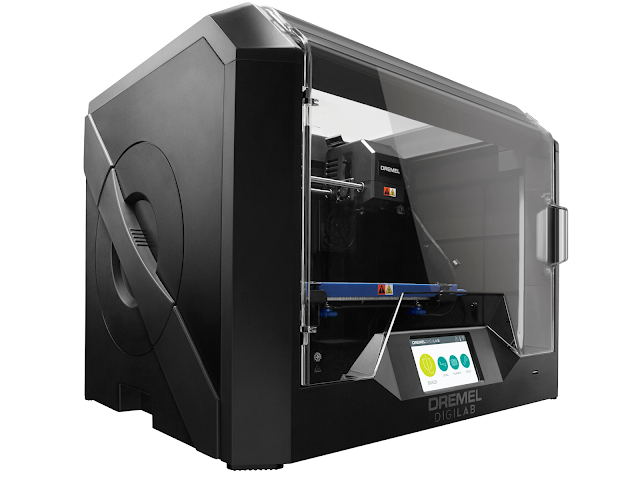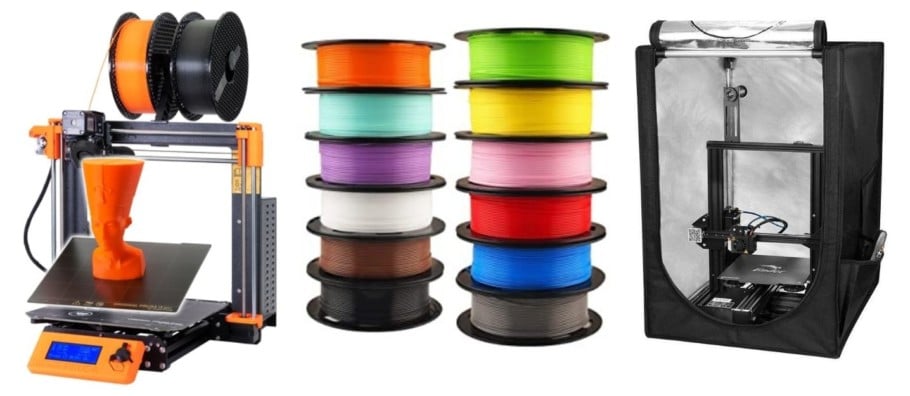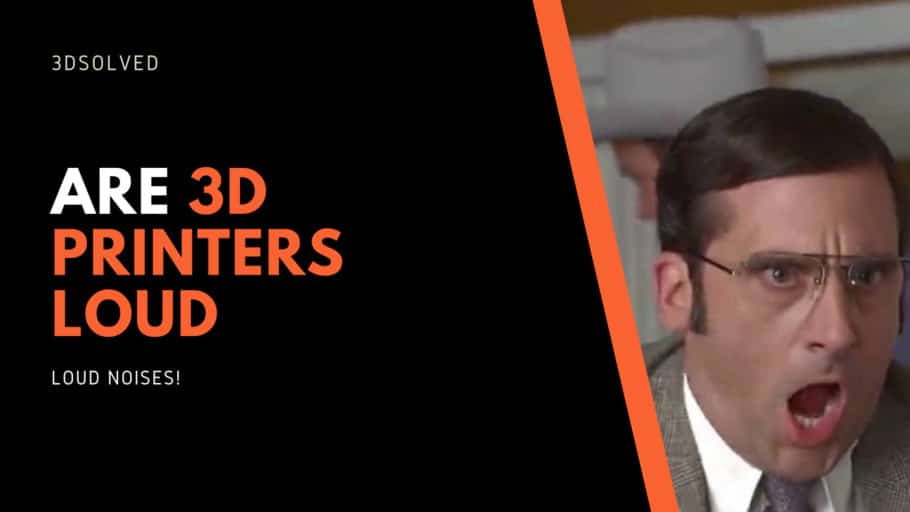If you’re thinking of buying your first 3D printer or changing your old one, you don’t want to be distracted by its sound while it’s working. It is not uncommon to ask oneself: “How loud is this machine going to be?”
Well in general, there are a lot of factors to be taken into consideration. Noise is mainly caused by the moving parts like fans, stepper motors, and the quality and quantity of these. Most hobbyist printers fall within a range of sound from 35db to 75 dB approximately (measured with a one-foot distance from the printer).
Towards the end of the article, you’ll have a well-formed overview of this topic.
How loud are FDM 3D printers in general?
Right now, the cheapest 3D printers usually tend to make sounds that go from 56 to 62 dB. This is roughly the same level as a normal conversation. The Creality Ender 3 makes around 56dB, whereas the Artillery Genius measures 60dB, just to name two well-known printers.
Other models make a lot less noise at the expense of a higher price. The Prusa I3 MK3 or the Dremel Digilab 3D45 get as low as 50 dB, and the Flashforge Adventurer 3, even reaches such low values as 45 dB. In other words, these printers are quieter than a refrigerator.
Are Resin Printers also loud?
Resin printers make some noise too, but they’re more silent in general. This is because all resin printers feature an enclosure. Although the main reason for enclosures is to keep the temperature inside constant and to protect the resin from dust, the quietness comes as a nice side effect.
A good example is the Elegoo Mars 2 Pro which makes a level of sound around 50 dB. If you take away the enclosure, it would be similar to the Ender 3 with around 56-60 dB. On the louder range of the spectrum, there are models like the Elegoo Saturn or the Anycubic Photon which can generate noises of roughly 54 dB.
What is the loudest part of a 3D printer?
The loudest parts of a 3D printer are its multiple fans. This happens because of their small size (40x10mm for the mainboard, hot end, and part cooling fans. And 60x10mm for the PSU one) and high RPMs, which makes a loud and high-pitched noise that will annoy anyone that happens to be in the vicinity. This is even more so in the case of the hotend fan and the part cooling fan.
Another important producer of noise are the stepper motors of the printer, and even the actual vibration caused by the printer can resonate with your table and make and create even more noises.
Thankfully, you can make it completely silent if your printer allows it. You just need to upgrade it with new and quieter parts.
How to lower the noise a 3D printer makes
There are plenty of ways to quiet down the printer, and while most involve upgrading it and replacing some components, there are still some ways you can go about it without actually touching the printer itself. Let’s take a look at both:
Reducing the noise of a 3d printer by changing components
As I previously mentioned, you can upgrade different parts of your 3D printer to make it nearly silent. Earlier, we said the loudest parts are the fans, so I highly recommend changing them to more silent ones. I would choose Noctua as they are a well-known brand with positive reviews everywhere. There are two key issues with them, first, you’ll need to buy a bigger one (40x20mm) due to the regular generating less airflow. Due to this you, you might need to print a new shroud for it. Here’s a full guide on how to swap the fans on an Ender 3.
And a video comparison before and after swapping them:
Second, you must check if your PSU (Power Supply Unit) is 24 volts or 12 volts because Noctua fans run on 12v. If you happen to have a 24v PSU, you will have to use a buck converter to lower the voltage in order to avoid damaging the fans. Luckily, these tend to be cheap (around ten dollars).
Next on the list are the stepper motors. There are two possible courses of action for these. To reduce their noise you can either put some dampers to the motors or change the mainboard of your printer with a quieter one, like the 32-bit mainboard on the Ender 3 V2 that has the TMC 2225 drivers that are dead silent. Without this modification, the motors will make noise every time the printhead makes a move. I’d recommend changing the mainboard over putting the dampers because it solves the noise issue once and for all.

Here you have a good article about reducing the noise of an Ender 3. It deals specifically with the Ender 3, but the main concepts are the same for most printers.
Reducing the noise without modifying the printer
You can also make your printer quieter without changing any part of your machine. There are many things you can do. For example, make a soundproof (and temperature preserving) enclosure, add vibration dampening feet, or placing the printer on top of anti-vibration pads.
The enclosure is a good option because it not only helps with the sound, but it also serves a wide range of functionalities, like protecting the electronic components from dust and maintaining the temperature inside of it allowing you to print with materials like ABS. You can make one by hand or buy it.
The vibration dampening feet prevent the vibration of the printer from making noises with your table. To make it easier and cheaper you can 3D print your own with flexible filament. You can also put your printer on a large concrete slab. It’ll absorb the vibration caused by the parts that are moving.
In some cases, you can print a PSU fan cover to redirect the noise away and make it less noticeable. This depends on the position of the PSU and its fan. Just be sure to print parts that are designed for your specific brand and model, since almost every printer has different specs.
The Quietest 3d Printers Available
Here I’ll list a handful of different printers that you can buy if you’re looking for a quiet plug-and-play machine.
Prusa I3 MK3s

Prusa made this model as silent as they could. This is thanks to a silent mainboard, that are able to keep those noisy stepper motors under control, in addition to Noctua fans. It also features a “Stealth Mode” to make it even quieter. This printer has a range of sound of around 50 dB.
Flashforge Adventurer 3

This printer operates between 45-50 dB when in use. This is mainly due to its enclosure which, as I mentioned earlier, it’s a nice way of reducing the noise it produces and allows you to use ABS plastic. And as a plus, it has a reliable Wi-Fi connectivity option, meaning that if the noise is still annoying you, you can put it in a different room of your house.
Dremel Digilab 3D45

Digilab has an enclosure and a great reputation for quality and user-friendliness. It’s great for beginners because it’s ready to use straight out of the box, so you just need to plug it in and start printing. It operates at an average of 50 dB.
Conclusion
As you know 3D printers are machines with a lot of movable parts, and these make noise when they move. For example, when the print head or the bed moves, when the fans are spinning, it is almost unavoidable to emit sounds.
In short, 3d printers will generate noises ranging from 35 to 75 dB, and where your printer falls in this range depends mainly on its price tag. The cheaper your printer is, the louder it will also probably be.
But thankfully, if your model allows for it, you can make a few upgrades to make it more silent. For example, swapping the stock fans with Noctua ones, or changing the mainboard for a silent one to make your stepper motors silent, among other solutions.
You can even lower the noise without swapping any component of the printer. You can build or buy an enclosure for your printer, which will not only help with the sound but will also allow you to print with a broader repertoire of materials.
Check out our recommended products section

We created a recommended products section that will allow you to remove the guesswork and reduce the time spent researching what printer, filament, or upgrades to get, since we know that this can be a very daunting task and which generally leads to a lot of confusion.
We have selected just a handful of 3D printers that we consider to be good for beginners as well as intermediates, and even experts, making the decision easier, and the filaments, as well as the upgrades listed, were all tested by us and carefully selected, so you know that whichever one you choose will work as intended.
Error processing API data.
